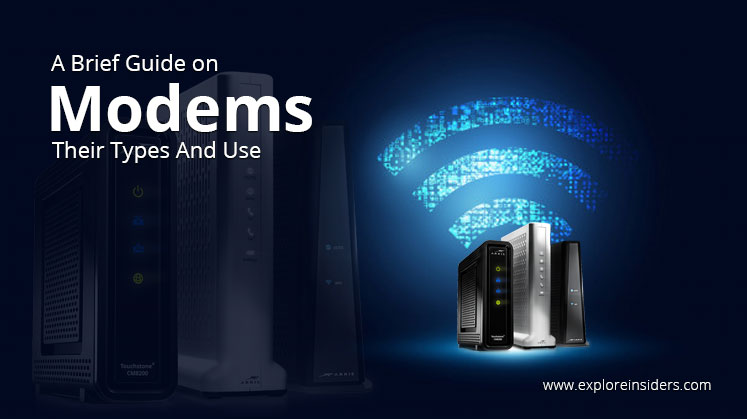A signal that transmits from one medium or equipment to another always requires some conversion for signal transmission. For example, a signal coming from the landline will be in the form of an analog signal. Your computer or other electronic device does not understand the analog signals, and the signals a device receives must be in digital form. The conversion of signals from analog to digital and vice versa is possible by using a modem. Modem word is a combination of modulator and demodulator. It means that it converts a signal from one form to another. A modem has two components that are as follows.
- A modulator (digital to analog signal conversion)
- A demodulator (Analog to digital signal conversion)
The strength of a modem to convert and transmit signal is measured using a unit called baud rate. It is the number of bits a modem can send or receive in a second. For optimum rates, it is a must that you use good and latest modems that are approved by the telecommunication authorities.
Keep scrolling the article to understand the modem types and what type of approvals they require for their further use.
Top 5 Different Types of Modems and Their Working:
With the evolution in technology and technical equipment, such equipment’s quality is getting better with time. There are mainly five types of modems that you may find in the market; each modem varies from the other in terms of its transmission rates and signal transmission speed.
Below are some of the modem types and how they are different from others in working.
1). DSL modem
DSL modems are a replacement for dial-up modems, and these use a landline connection for the signal transmission. With dia-up modems, you could not multitask; like you could either talk over the phone or use the internet, both tasks were impossible to perform simultaneously. DSL modems made this possible by dividing the total bandwidth into a 70% and 30% ratio. A greater percentage, i.e., 70%, is for the internet and 30% for phone calls.
2). Wireless modems
Wireless modems are one of the modern and latest types of modems that are available in the market. These modems do not require any cable or wire for connectivity with the device and use radio frequency to transmit signals. It is a radio and telecommunication terminal equipment, and the modem needs to have TRA type approval before its use and sale.
3). External modem
A modem consists of different ports for connectivity to other devices. The device connects through a cable to communication1 and communication2 or com1 and com2 ports in an external modem. For the connectivity and working of an external modem, you need a power supply. Plugin the power supply to the modem, and then you are ready to use it. It is one of the easiest modems to set up without worrying about its installation.
4). Internal modem
Internal modems are a part of the device. It is inside the machine, and you attach the modem to the system using expansion slots. Internal modems are not portable like external modems; you cannot move or replace the modem from one device to another easily. One advantage of internal modems over the external modem is that you do not have to set up an external power supply. It gets its power from the system once installed on the motherboard.
5). ISDN modem
ISDN modems are one of the old forms of modems, and these modems are most like DSL modems because both types use a single wire for connectivity and signal transmission. For their work, ISDN modems require amplifiers at specific distances to amplify the signal because, without these amplifiers, modems will fail to transmit signals to larger distances.
Benefits of using Modems in Networks and Connectivity:
There are a few reasons why people still use modems in different types of networks. Some of the reasons for their use are as follows.
1). Signal transmission and conversion
One of the benefits that modems provide is signal conversion and transmission. A modem has both qualities of receiving an analog signal and then converting the analog signal to digital form and sending it to the device and vice versa.
2). Portable modems
Modems are portable and wireless, so they are very handy to take them anywhere with you for internet access. Portable modems are compatible with any device, smartphone, tablet, and personal computer. Your modems must meet certain requirements and standards for their compatibility with all the gadgets, and to ensure they are up to the standards and comply with the RTTE requirements, you must get the TRA type approval for such equipment.
3). Voice over data
Modern modems allow you to multitask. You can attend a call and use the internet services simultaneously, unlike previous modem types, which were incapable of providing multitasking benefits for their users.
A Final Wrap Up:
The modems and their types vary because of their signal transmission rate and signal transmission speed. It is very important for better networking to use the best modems that comply with the RTTE standards and requirements.
Learn More:
Types of High-Speed Internet Connections


